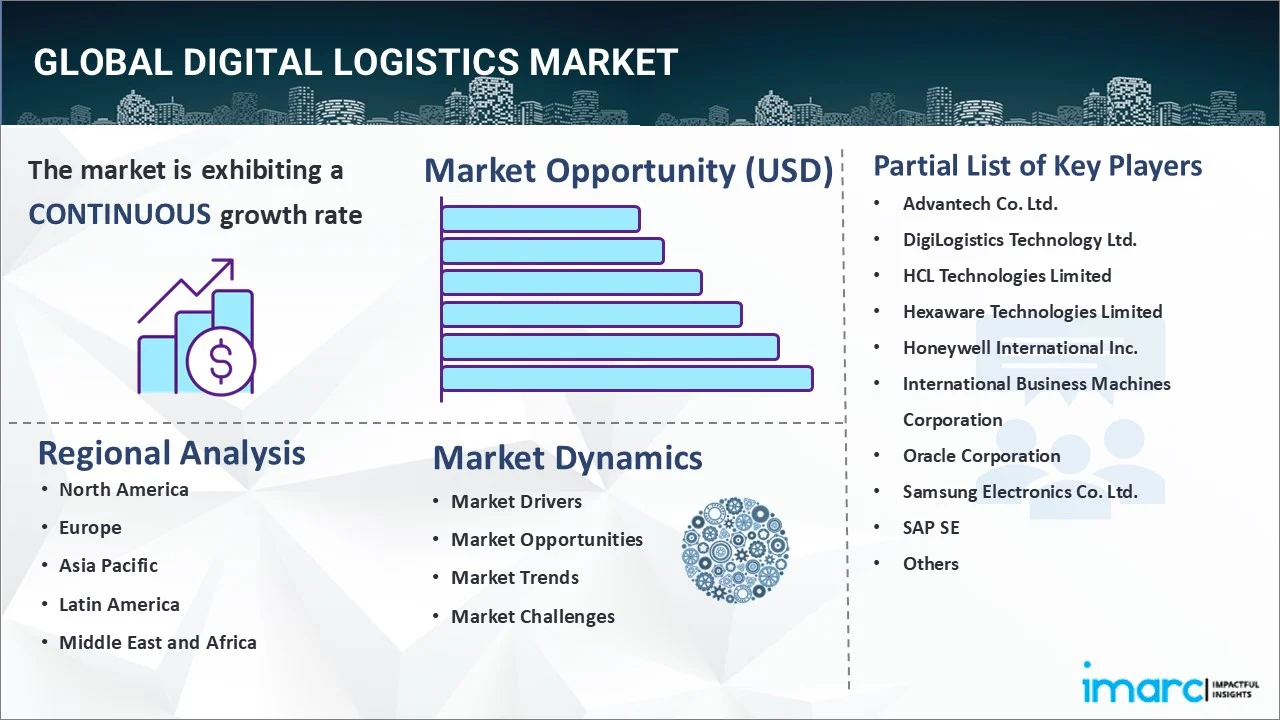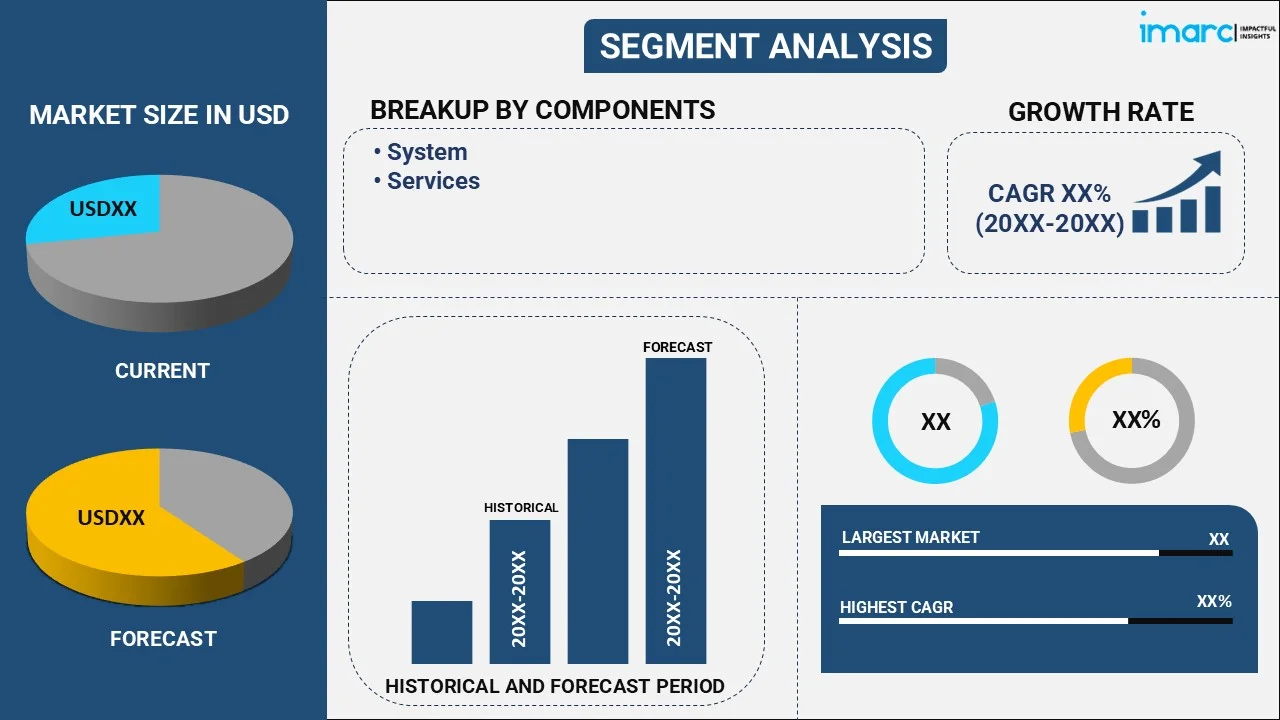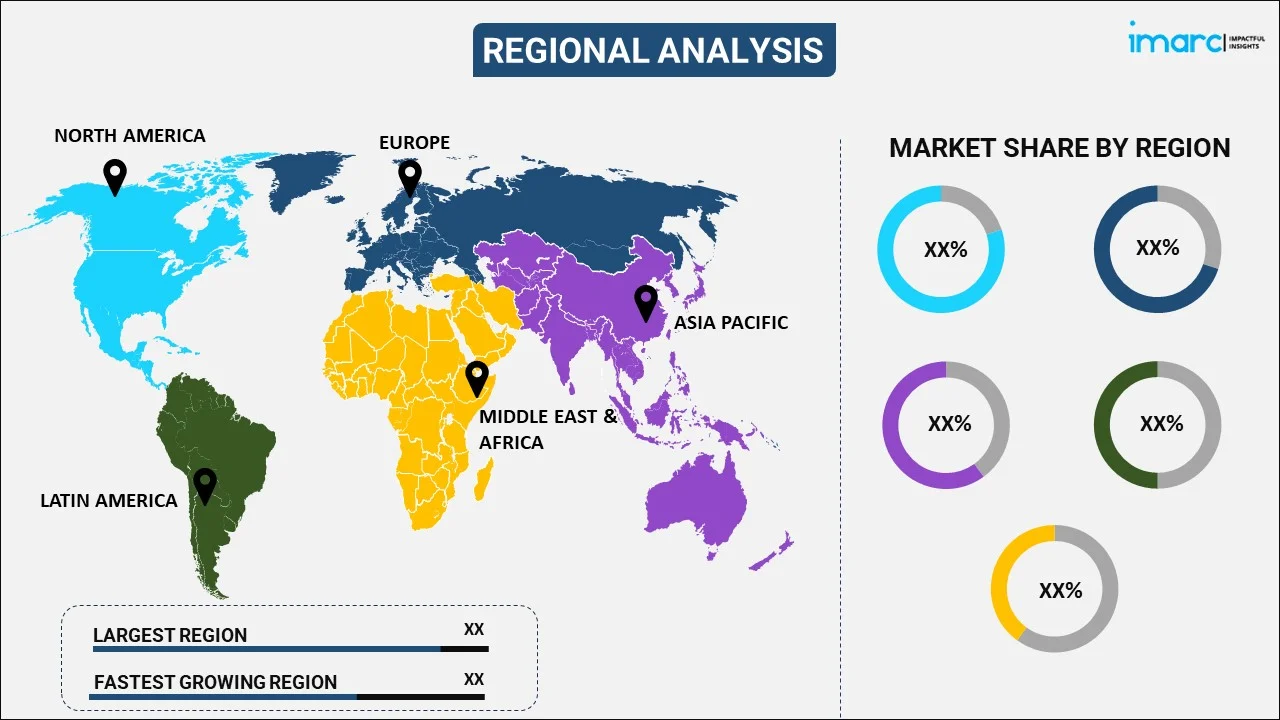
Digital Logistics Market Report by Component (System, Services), Application (Warehouse Management, Labor Management, Transport Management), Industry Vertical (Retail and eCommerce, Manufacturing, Pharmaceuticals and Healthcare, Aerospace and Defense, Energy and Utilities, Automotive, and Others), and Region 2025-2033
Digital Logistics Market Overview:
The global digital logistics market size reached USD 30.6 Billion in 2024. Looking forward, IMARC Group expects the market to reach USD 127.1 Billion by 2033, exhibiting a growth rate (CAGR) of 16.3% during 2025-2033. The market is driven by the growing adoption of predictive maintenance and IoT-enabled sensors to ensure that vehicles run efficiently and cut down on energy waste, rising utilization of robotics and automation in warehouses and fulfillment centers to handle the large number of orders, and thriving e-commerce industry.
|
Report Attribute
|
Key Statistics
|
|---|---|
|
Base Year
|
2024
|
|
Forecast Years
|
2025-2033
|
|
Historical Years
|
2019-2024
|
|
Market Size in 2024
|
USD 30.6 Billion |
|
Market Forecast in 2033
|
USD 127.1 Billion |
| Market Growth Rate 2025-2033 | 16.3% |
Digital Logistics Market Analysis:
- Major Market Drivers: The growing utilization of AI and machine learning (ML) to improve delivery routes while cutting down on emissions and fuel use is positively influencing the market.
- Key Market Trends: The rising demand for advanced last-mile delivery technologies for same-day or next-day delivery is propelling the growth of the market.
- Geographical Trends: North America enjoys the leading position in the market on account of the adoption of advanced technologies like blockchain, IoT, AI, and machine learning (ML) in the logistics industry.
- Competitive Landscape: Some of the major market players in the digital logistics industry include Advantech Co. Ltd., DigiLogistics Technology Ltd., HCL Technologies Limited, Hexaware Technologies Limited, Honeywell International Inc., International Business Machines Corporation, Oracle Corporation, Samsung Electronics Co. Ltd., SAP SE, and Tech Mahindra Limited, among many others.
- Challenges and Opportunities: While the market faces challenges like managing cybersecurity risks and data privacy concerns, it also encounters opportunities in leveraging AI and IoT for enhanced operational efficiency.

To get more information on this market, Request Sample
Digital Logistics Market Trends:
Sustainability initiatives in logistics
Digital logistics solutions are relying on AI and ML to enhance delivery routes while lowering emissions and fuel utilization. To ensure that vehicles are running efficiently, predictive maintenance and IoT-enables sensors are used, as they are also beneficial in decreasing energy waste. Besides this, key players are integrating electric and hybrid vehicles into their logistics processes. This helps them to achieve their sustainability goals while attracting environment conscious companies. For instance, in 2024, Aramex introduced electric motorcycles (e-bikes) to its last-mile delivery fleet in the UAE to align with its ambitious sustainability goals, aiming for 98% electric vehicle fleet by 2030 and achieving net-zero emissions by 2050. By optimizing packing sizes and materials, digital logistics systems may cut waste and increase sustainability, which is contributing to the digital logistics market growth.
Thriving e-commerce industry
According to the IMARC Group’s report, the global e-commerce market reached US$ 21.1 Trillion in 2023. Advanced last-mile delivery technologies are developed in response to the expectation of same-day or next-day delivery. To effectively satisfy these expectations, digital logistics technologies optimize delivery schedules and routes. People nowadays are preferring real time order tracking, and it is made possible by digital logistics. When shipments are tracked in real-time, it increases transparency and buyer satisfaction. Moreover, as there is a large of orders, robotics and automation are highly used in warehouses and fulfillment centers to manage these orders. E-commerce platforms are highly preferable by people due to the convenience they provide to them, which is catalyzing the demand for digital logistics. Digital logistics can fulfill the order from warehouses, stores, and drop-shippers, making them valuable for several companies.
Rising demand for warehouse management
There is a rise in the demand for automated storage and retrieval systems (AS/RS) to minimize the time and effort required for inventory management by enhancing storage density and retrieval speed. Human error is decreased due to the utilization of robotics in picking, packing, sorting, and handling materials. There are several warehouse operations like receiving, putting-away, picking, packing, and shipping. To manage these operations, warehouse management systems (WMS) software is used with other digital logistics systems. To have accesses to the most recent data about inventory levels and movements of goods in warehouses, IoT devices are highly preferable. These technologies make it easier to track and handle commodities accurately, which increases inventory accuracy and lowers loss rates. Cloud-based technologies enable firms to operate many warehouses from a single platform because of its scalability, flexibility, and accessibility. As a result, key players operating in the warehouse management market are introducing their private cloud to ensure improved inventory consistency, enhanced process transparency, and reduced clerical efforts and errors. For instance, in 2024, SAP SA announced the release of SAP Extended Warehouse Management (EWM) in SAP S/4HANA 2023 FPS01, private cloud to empower businesses of all sizes, optimize their supply chain execution, and run their warehouse operations with efficiency and agility.
Digital Logistics Industry Segmentation:
IMARC Group provides an analysis of the key trends in each segment of the market, along with forecasts at the global, regional, and country levels for 2025-2033. Our report has categorized the market based on component, application, and industry vertical.
Breakup by Component:

- System
- Tracking and Monitoring System
- Information Integrated System
- Electronic Data Interchange System
- Database Management System
- Fleet Management and Order Management System
- Services
- Consulting
- System Integration
The report has provided a detailed breakup and analysis of the market based on the component. This includes system (tracking and monitoring system, information integrated system, electronic data interchange system, database management system, and fleet management and order management system) and services (consulting and system integration).
Systems include all of the tools and platforms that are used to optimize and streamline logistics processes. These systems consist of enterprise resource planning (ERP), transportation management systems (TMS), warehouse management systems (WMS), and other specialist software programs.
Services are highly important as organizations need various support and consulting services to deploy, operate, and optimize their digital logistics services. Service providers help businesses implement logistics solutions that are customized to meet their unique requirements while guaranteeing a smooth integration with current systems and procedures, which is offering a favorable digital logistics market outlook.
Breakup by Application:
- Warehouse Management
- Labor Management
- Transport Management
Warehouse management holds the largest share of the industry
A detailed breakup and analysis of the market based on the application have also been provided in the report. This includes warehouse management, labor management, and transport management. According to the report, warehouse management accounts for the largest market share.
In the entire supply chain, warehouses are known as crucial components for storage, distribution, and management of goods. To minimize delays and ensure that things are available and accessible when needed, effective warehouse management is required. To handle the increased complexity and scope of activities, ranging from receiving and storing to picking, packaging, and shipping orders, this surge calls for sophisticated warehouse management solutions.
Breakup by Industry Vertical:
- Retail and eCommerce
- Manufacturing
- Pharmaceuticals and Healthcare
- Aerospace and Defense
- Energy and Utilities
- Automotive
- Others
Automotive represents the leading market segment
The report has provided a detailed breakup and analysis of the market based on the industry vertical. This includes retail and ecommerce, manufacturing, pharmaceuticals and healthcare, aerospace and defense, energy and utilities, automotive, and others. According to the report, automotive represents the largest segment.
The global supply chains of the automotive industry are extremely complex and involve many manufacturers, suppliers, and distributors. Coordinating the movement of subassemblies, completed cars, and components across borders calls for sophisticated digital logistics solutions to maximize productivity and reduce downtime. Just-in-time (JIT) production techniques, in which parts are provided precisely when needed in the production process, are crucial to the automotive industry. To enable just-in-time (JIT) operations, manage the exact scheduling and sequencing of deliveries, lower inventory costs, and prevent production delays, digital logistics solutions are crucial, which is positively influencing the digital logistics market revenue.
Breakup by Region:

- North America
- United States
- Canada
- Europe
- Germany
- France
- United Kingdom
- Italy
- Spain
- Others
- Asia Pacific
- China
- Japan
- India
- South Korea
- Australia
- Indonesia
- Others
- Latin America
- Brazil
- Mexico
- Others
- Middle East and Africa
North America leads the market, accounting for the largest digital logistics market share
The report has also provided a comprehensive analysis of all the major regional markets, which include North America (the United States and Canada); Europe (Germany, France, the United Kingdom, Italy, Spain, and others); Asia Pacific (China, Japan, India, South Korea, Australia, Indonesia, and others); Latin America (Brazil, Mexico, and others); and the Middle East and Africa. According to the report, North America represents the largest regional market for digital logistics.
North America is a global leader in technological innovations, especially the United States. Advanced technologies like blockchain, IoT, AI, and machine learning (ML) are widely adopted in the region and are essential to digital logistics solutions. The need for effective and flexible logistics solutions is increasing significantly as a result of the North American e-commerce industry's meteoric growth. E-commerce companies are raising the bar for prompt and dependable delivery, forcing the logistics sector to adapt digital solutions for being competitive. In addition, key players are focusing on enhancing their warehouse management capabilities to fulfil the demands of fast-paced omni-channel environment. For instance, in 2023, Seedcom digitally transformed the warehousing capabilities of its logistics company, Seedcom Logistics, with Blue Yonder. The company completed a successful implementation of Blue Yonder’s Warehouse Management System (WMS) to transform its warehouse environment.
Competitive Landscape:
- The market research report has also provided a comprehensive analysis of the competitive landscape in the market. Detailed profiles of all major digital logistics companies have also been provided. Some of the major market players in the digital logistics industry include Advantech Co. Ltd., DigiLogistics Technology Ltd., HCL Technologies Limited, Hexaware Technologies Limited, Honeywell International Inc., International Business Machines Corporation, Oracle Corporation, Samsung Electronics Co. Ltd., SAP SE, and Tech Mahindra Limited.
(Please note that this is only a partial list of the key players, and the complete list is provided in the report.)
- To satisfy the industry's rising expectations, major firms in the market are constantly inventing and enhancing their capacities. For improving the effectiveness and transparency of logistics operations, businesses are utilizing cutting-edge technologies like blockchain, Internet of Things (IoT), machine learning (ML), and artificial intelligence (AI). These companies are creating and implementing all-encompassing digital logistics platforms that incorporate many aspects of the supply chain, such as transportation, warehouse operations, and last-mile delivery, in addition to inventory management. For example, IBM's blockchain technology is being utilized to improve supply chain traceability and trust by producing visible, unchangeable transaction records. Furthermore, in order to lessen carbon footprints and encourage environment friendly behaviors, these businesses are placing a strong emphasis on sustainability in their logistics solutions. Through route optimization, fuel efficiency enhancements, and the integration of energy-saving technologies, they assist enterprises in accomplishing their sustainability objectives. In addition, key players are focusing on collaborations, partnerships, and acquisitions to expand their customer base, which is increasing the digital logistics market price trends. For instance, in 2023, UPS announced that it has entered into an agreement to acquire Happy Returns from PayPal, which is a U.S.-based software and reverse logistics company that enables frictionless, no-box, no-label returns for merchants and buyers.
Digital Logistics Market News:
- In 2023: SGTraDex and shipping lines OOCL, PIL and ONE extended digital logistics innovation MoU with key partnerships from shipping lines, including PSA Corporation Ltd, CargoERP, Innosys, Keyfields, Haulio, CDAS, SLA and STA.
- In 2023: Osa Commerce announced a strategic partnership with Techdinamics to support logistics providers and retailer's digital transformation.
Digital Logistics Market Report Scope:
| Report Features | Details |
|---|---|
| Base Year of the Analysis | 2024 |
| Historical Period | 2019-2024 |
| Forecast Period | 2025-2033 |
| Units | Billion USD |
| Scope of the Report | Exploration of Historical Trends and Market Outlook, Industry Catalysts and Challenges, Segment-Wise Historical and Future Market Assessment:
|
| Components Covered | System: Tracking and Monitoring System, Information Integrated System, Electronic Data Interchange System, Database Management System, Fleet Management and Order Management System Services: Consulting, System Integration |
| Applications Covered | Warehouse Management, Labor Management, Transport Management |
| Industry Verticals Covered | Retail and eCommerce, Manufacturing, Pharmaceuticals and Healthcare, Aerospace and Defense, Energy and Utilities, Automotive, Others |
| Regions Covered | North America, Europe, Asia Pacific, Latin America, Middle East and Africa |
| Countries Covered | United States, Canada, Germany, France, United Kingdom, Italy, Spain, China, Japan, India, South Korea, Australia, Indonesia, Brazil, Mexico |
| Companies Covered | Advantech Co. Ltd., DigiLogistics Technology Ltd., HCL Technologies Limited, Hexaware Technologies Limited, Honeywell International Inc., International Business Machines Corporation, Oracle Corporation, Samsung Electronics Co. Ltd., SAP SE, Tech Mahindra Limited, etc. |
| Customization Scope | 10% Free Customization |
| Post-Sale Analyst Support | 10-12 Weeks |
| Delivery Format | PDF and Excel through Email (We can also provide the editable version of the report in PPT/Word format on special request) |
Key Questions Answered in This Report:
- How has the global digital logistics market performed so far, and how will it perform in the coming years?
- What are the drivers, restraints, and opportunities in the global market?
- What is the impact of each driver, restraint, and opportunity on the global market?
- What are the key regional markets?
- Which countries represent the most attractive digital logistics market?
- What is the breakup of the market based on the component?
- Which is the most attractive component in the market?
- What is the breakup of the market based on the application?
- Which is the most attractive application in the market?
- What is the breakup of the market based on the industry vertical?
- Which is the most attractive industry vertical in the market?
- What is the competitive structure of the market?
- Who are the key players/companies in the global digital logistics market?
Key Benefits for Stakeholders:
- IMARC’s industry report offers a comprehensive quantitative analysis of various market segments, historical and current market trends, digital logistics market forecasts, and dynamics of the market from 2019-2033.
- The research report provides the latest information on the market drivers, challenges, and opportunities in the global market.
- The study maps the leading, as well as the fastest-growing, regional markets. It further enables stakeholders to identify the key country-level markets within each region.
- Porter's five forces analysis assists stakeholders in assessing the impact of new entrants, competitive rivalry, supplier power, buyer power, and the threat of substitution. It helps stakeholders to analyze the level of competition within the digital logistics industry and its attractiveness.
- The competitive landscape allows stakeholders to understand their competitive environment and provides insight into the current positions of key players in the market.
Need more help?
- Speak to our experienced analysts for insights on the current market scenarios.
- Include additional segments and countries to customize the report as per your requirement.
- Gain an unparalleled competitive advantage in your domain by understanding how to utilize the report and positively impacting your operations and revenue.
- For further assistance, please connect with our analysts.
 Request Customization
Request Customization
 Speak to an Analyst
Speak to an Analyst
 Request Brochure
Request Brochure
 Inquire Before Buying
Inquire Before Buying




.webp)




.webp)












